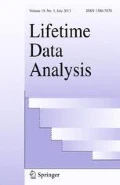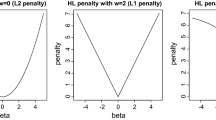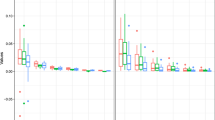Abstract
Recently, Fine and Gray (J Am Stat Assoc 94:496–509, 1999) proposed a semi-parametric proportional regression model for the subdistribution hazard function which has been used extensively for analyzing competing risks data. However, failure of model adequacy could lead to severe bias in parameter estimation, and only a limited contribution has been made to check the model assumptions. In this paper, we present a class of analytical methods and graphical approaches for checking the assumptions of Fine and Gray’s model. The proposed goodness-of-fit test procedures are based on the cumulative sums of residuals, which validate the model in three aspects: (1) proportionality of hazard ratio, (2) the linear functional form and (3) the link function. For each assumption testing, we provide a \(p\)-values and a visualized plot against the null hypothesis using a simulation-based approach. We also consider an omnibus test for overall evaluation against any model misspecification. The proposed tests perform well in simulation studies and are illustrated with two real data examples.



Similar content being viewed by others
References
Andersen PK, Borgan Ø, Gill RD, Keiding N (1993) Statistical models based on counting processes. Springer-Verlag, New York
Dickson E, Grambsch P, Fleming T, Fisher LD, Langworthy A (1989) Prognosis in primary biliary cirrhosis: model for decision making. Hepatology 10:1–7
Fine JP, Gray RJ (1999) A proportional hazards model for the subdistribution of a competing risk. J Am Stat Assoc 94:496–509
Fleming TR, Harrington DP (1991) Counting processes and survival analysis. Wiley, New York
Kim H (2007) Cumulative incidence in competing risks data and competing risks regression analysis. Clin Cancer Res 13:559–565
Lau B, Cole S, Gange S (2009) Competing risk regression models for epidemiologic data. Am J Epidemiol 170:244–256
Lin DY, Wei LJ, Ying Z (1993) Checking the Cox model with cumulative sums of martingale-based residuals. Biometrika 80:557–572
Perme M, Andersen P (2008) Checking hazard regression models using pseudo-observations. Stat Med 27(25):5309–5328
Scheike TH, Zhang MJ (2008) Flexible competing risks regression modelling and goodness-of-fit. Lifetime Data Anal 14:464–483 pMCID: PMC2715961
Scheike TH, Zhang MJ, Gerds T (2008) Predicting cumulative incidence probability by direct binomial regression. Biometrika 95:205–220 pMC Journal-In Process
Scrucca L, Santucci A, Aversa F (2007) Competing risk analysis using R: an easy guide for clinicians. Bone Marrow Transpl 40(4):381–387
Weisdorf D, Eapen M, Ruggeri A, Zhang M, Zhong X, Brunstein C, Ustun C, Rocha V, Gluckman E (2013) Alternative donor hematopoietic transplantation for patients older than 50 years with aml in first complete remission: unrelated donor and umbilical cord blood transplantation outcomes. Blood 122:302
Wolbers M, Koller M, Witteman J, Steyerberg E (2009) Prognostic models with competing risks: methods and application to coronary risk prediction. Epidemiology 20(4):555–561
Zhou B, Fine J, Laird G (2013) Goodness-of-fit test for proportional subdistribution hazards model. Stat Med 32(22):3804–3011
Author information
Authors and Affiliations
Corresponding author
Appendix
Appendix
Consider the following partial sums of residuals
where \(f(x,\varvec{Z}_i,\varvec{v},p)=(\varvec{v}^\mathsf T \varvec{Z}_i)^p 1\!\!1\left( \varvec{v}^\mathsf T \varvec{Z}_i\le x\right) \). Here \(\varvec{v}\) is a vector with same dimension of covariates \(\varvec{Z}\), and \(p=0\) or \(1\). Under the null hypothesis that the FG model is valid,
Taking the Taylor expansion of \(\varvec{U}(\hat{\varvec{\beta }},t)\) at \(\varvec{\beta }_0\), we can obtain
where \(\varvec{\varOmega }=\lim _{n\rightarrow \infty }\varvec{I}(\varvec{\beta }_0)/n\) and asymptotically \(\varvec{U}(\varvec{\beta }_0)\) can be expressed as the sum of \(n\) independent and identically distributed random variables, i.e. \(n^{-1/2}\varvec{U}(\varvec{\beta }_0)=n^{-1/2}\sum _{i=1}^n(\varvec{\eta _i}+\varvec{\psi _i})\,{+}\,o_p(1)\) (for explicit expressions of \(\varvec{\eta _i}\) and \(\varvec{\psi _i}\) see Fine and Gray (1999)). Since \(\varvec{\eta _i}\) contributes the majority of the variability, so we call \(\varvec{\eta _i}\) major term and \(\varvec{\psi _i}\) minor term. Both \(\varvec{\eta _i}\) and \(\varvec{\psi _i}\) are zero-mean Gaussian processes. Therefore
Recall that
therefore
Further more, for (11), taking the Taylor expansion of \(1/S_0(\hat{\varvec{\beta }},u)\) at \(\varvec{\beta }_0\), we can obtain
For (12),
where
Plug (11) and (12) into (9) we have
Under the asymptotic regularity conditions:
Exchange summation on (14) and combine with (7). When \(n\mathop {\rightarrow }\limits ^{p}\infty \),
where
Combine (8) and (15). When \(n\mathop {\rightarrow }\limits ^{p}\infty \),
where
Exchange summation on (16). When \(n\mathop {\rightarrow }\limits ^{p}\infty \),
where
So
where
which can be consistently estimated by the plug-in estimators.
1.1 Test proportional subdistribution hazards assumption:
To check the proportional subdistribution hazards assumption, we consider the score process \(U_j(\hat{\varvec{\beta }},t)\) for each covariate, which can be written as
It is a special case of the general form \(\varvec{B}(t,x)\) with \(x=\infty \), \(p=1\) and \(\varvec{v}\) has \(1\) in \(j\)th element and \(0\) elsewhere. Under the null hypothesis,
where \(s_{1j}(\varvec{\beta }_0,u)\) is the \(j\)th element of \(\varvec{s}_1(\varvec{\beta },u)\) and
In practice, we standardized the process by multiplying \(I_{jj}^{-1}(\hat{\varvec{\beta }})\), and denoted \(B^{(p)}_j(t)=I_{jj}^{-1}(\hat{\varvec{\beta }})U_j(\hat{\varvec{\beta }},t)\) in the text.
1.2 Test linear functional form
To test the linear functional form for the \(j\)th covariate, we consider
which is a special case of the general form \(\varvec{B}(t,x)\) when \(t=\infty \), \(p=0\), and \(\varvec{v}\) has \(1\) in \(j\)th element and \(0\) elsewhere. Under the null hypothesis,
where
1.3 Test link function
To test the link function, we consider
In this case, \(t=\infty \), \(p=0\) and \(\varvec{v}=\hat{\varvec{\beta }}\). Under the null hypothesis, the test statistic has exactly the same format as the test statistic in the linear functional form, except the indictor function is replaced by \(1\!\!1\left\{ \hat{\varvec{\beta }}^\mathsf{T } \varvec{Z}_{i} \le x\right\} \). Note, if there is only one covariate, checking the function is equivalent to checking the functional form of the covariate.
1.4 Omnibus test
Here we consider
For the \(j\)th covariate is of interest for testing, the \(j\)th element in \(\varvec{B}^{(o)}(t,x)\) is the statistic we look for,
which is a special case of the general form \(\varvec{B}(t,x)\) when \(p=0\) and and \(\varvec{v}\) has \(1\) in \(j\)th element and \(0\) elsewhere. The omnibus test also can be viewed as recording each linear function test through the time span. Under the null hypothesis,
where
Rights and permissions
About this article
Cite this article
Li, J., Scheike, T.H. & Zhang, MJ. Checking Fine and Gray subdistribution hazards model with cumulative sums of residuals. Lifetime Data Anal 21, 197–217 (2015). https://doi.org/10.1007/s10985-014-9313-9
Received:
Accepted:
Published:
Issue Date:
DOI: https://doi.org/10.1007/s10985-014-9313-9




